Mutual Aid (original) (raw)
Mutual Aid
Mutual Aid2024-04-05T08:53:24-04:00
What is Mutual Aid? and How to Start a Network?
What is Mutual Aid?
In a world ruled by ceaseless capitalist competition, where people are pitted to work against each other, anarchists offer a different vision: Mutual Aid.-
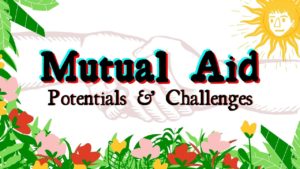
Mutual Aid is a radical concept that humans have practised across millennia, but these days, its exact purpose and potential remains vague in the minds of many. What is it? What is it not? What challenges will we face? How can we use it to build towards revolution? -
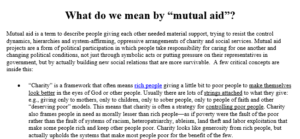
Mutual aid is a term to describe people giving each other needed material support, trying to resist the control dynamics, hierarchies and system-affirming, oppressive arrangements of charity and social services. -
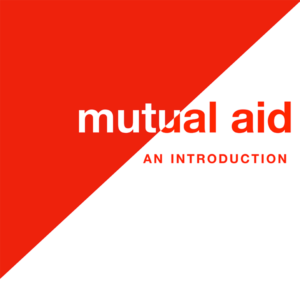
I made this zine for absolute beginners, including people perhaps without fully-worked-out political or theoretical commitments. The intention is not to give people a full education, nor to nail down what mutual aid ‘is’. Rather, I wanted to provide some small tools that can get people started with the practice of mutual aid. Doing is the best political education! Comrades and long-term organisers will no doubt find much to criticise in this necessarily limited & partial account. I wouldn’t have it any other way! Thanks so much to all readers. In love and solidarity, -
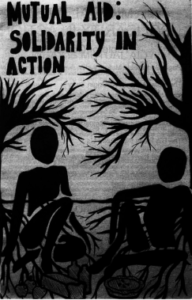
Do you ever spend time thinking about where the food you eat, or the clothes you wear come from? What about the labor and materials that went into building your house or your car? Left to fend for ourselves without the comforts of community, few among us would survive a week. None of us would be able to provide the food, medicine, clothing, shelter, and everything else our lives depend on. We need each other. -

Been hearing a lot about mutual aid lately? Wonder where it comes from and what the principles behind it are? Come hear from folks on the frontlines of mutual aid as they support us getting our learn on! -
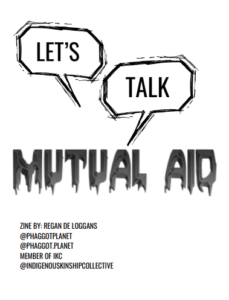
So, in the time of covid-19, we have seen so many calls to and for “Mutual Aid”. Which is dope, great, awesome, important, but also has led to some confusion (dare I say co-option) as to what mutual is and isn't. -
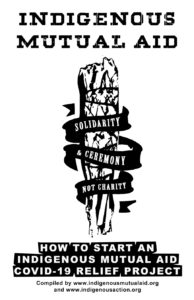
We decided to create this guide as we found that most resources currently available for COVID-19 Mutual Aid organizing were insufficient compared to discussions with other Mutual Aid projects and our own experiences working with two Indigenous Mutual Aid groups (Kinłani Mutual Aid & Navajo and Hopi Families COVID-19 Relief). Aside from this guide, we highly recommend that you talk directly with other Mutual Aid organizers to get a sense of what organizing frameworks may work best in your area. -
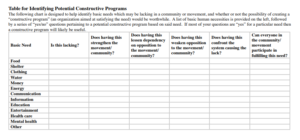
The following chart is designed to help identify basic needs which may be lacking in a community or movement, and whether or not the possibility of creating a “constructive program” (an organization aimed at satisfying the need) would be worthwhile -
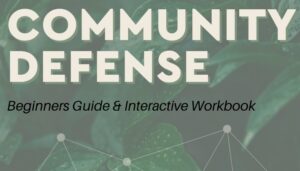
6 steps that will prompt you to assess need, audience, training, triggers, capacity, and resources in the context of your specific community. -
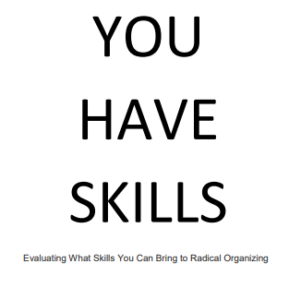
Frontline Praxis and Mutual Aid Disaster Relief
It’s really easy when looking at the big picture of organizing, to not know where to start or how to help. It can get debilitating and paralyzing. -
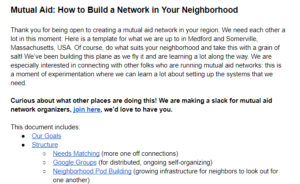
Thank you for being open to creating a mutual aid network in your region. We need each other a lot in this moment. Here is a template for what we are up to in Medford and Somerville, Massachusetts, USA. Of course, do what suits your neighborhood and take this with a grain of salt! We’ve been building this plane as we fly it and are learning a lot along the way. -

We decided to create this guide as we found that most resources currently available for COVID-19 Mutual Aid organizing were insufficient compared to discussions with other Mutual Aid projects and our own experiences working with two Indigenous Mutual Aid groups. -

People are worried and are also trying to be there for each other in ways large and small. The purpose of this resource is to help folks put together a very local phone tree: the first building block to help make sure that folks stay connected no matter what, and receive the support they need in a timely way. -
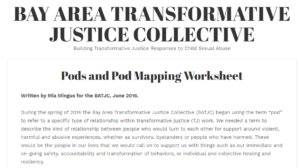
Bay Area Transformative Justice Collective
During the spring of 2014 the Bay Area Transformative Justice Collective (BATJC) began using the term “pod” to refer to a specific type of relationship within transformative justice (TJ) work. We needed a term to describe the kind of relationship between people who would turn to each other for support around violent, harmful and abusive experiences, whether as survivors, bystanders or people who have harmed. -
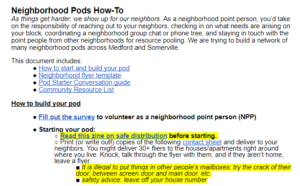
As things get harder, we show up for our neighbors. As a neighborhood point person, you’d take on the responsibility of reaching out to your neighbors, checking in on what needs are arising on your block, coordinating a neighborhood group chat or phone tree, and staying in touch with the point people from other neighborhoods for resource pooling. -
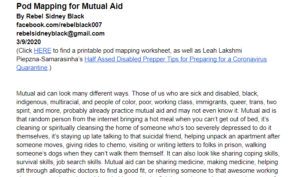
Mutual aid can look many different ways. Those of us who are sick and disabled, black, indigenous, multiracial, and people of color, poor, working class, immigrants, queer, trans, two spirit, and more, probably already practice mutual aid and may not even know it. -

Now that you know what mutual aid is, let's talk about how to do it. -
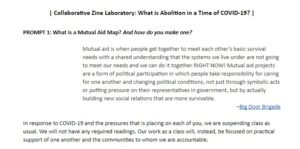
What is a Mutual Aid Map? And how do you make one? -
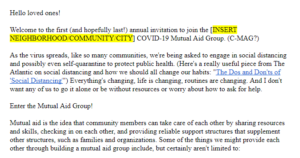
Hello loved ones! Welcome to the first (and hopefully last!) annual invitation to join the [INSERT NEIGHBORHOOD/COMMUNITY/CITY] COVID-19 Mutual Aid Group. (C-MAG?) As the virus spreads, like so many communities, we're being asked to engage in social distancing and possibly even self-quarantine to protect public health. -
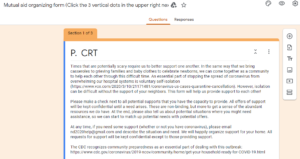
Times that are potentially scary require us to better support one another. In the same way that we bring casseroles to grieving families and baby clothes to celebrate newborns, we can come together as a community to help each other through this difficult time. An essential part of stopping the spread of coronavirus from overwhelming our hospital systems is voluntary self-isolation -
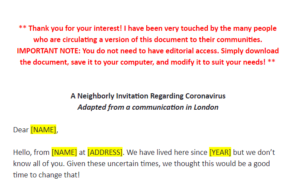
Thank you for your interest! I have been very touched by the many people who are circulating a version of this document to their communities. IMPORTANT NOTE: You do not need to have editorial access. Simply download the document, save it to your computer, and modify it to suit your needs! -
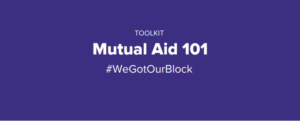
This toolkit includes step by step instructions for how you can build your
own mutual aid network while staying safe from the spread of COVID-19. -
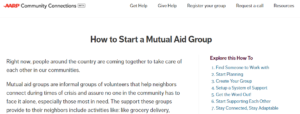
Right now, people around the country are coming together to take care of each other in our communities. Mutual aid groups are informal groups of volunteers that help neighbors connect during times of crisis and assure no one in the community has to face it alone, especially those most in need. -
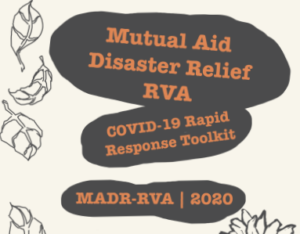
Mutual Aid Disaster Relief Richmond
Welcome to the Mutual Aid Disaster Relief Richmond Toolkit!
We have created this document as a resource for both our new
volunteers and others who are interested in starting their own
mutual aid projects
Mutual Aid Legal Cafe Teach-In
PRESENTERS: Tia Katrina Taruc-Myers (Law Center) Charlotte Tsui (Law Center) Sarah Kaplan (Cutting Edge Counsel) AGENDA: 1. Intro to mutual aid - Examples of...
Mutual Aid and the Law
This is a workshop on some of the most common legal questions we've heard coming up for mutual aid groups that have formed in response to the pandemic. It's ...-
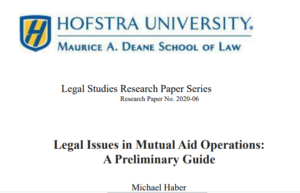
The first words of the first draft of this guide were written on May 14, 2020, when COVID-19 was the lead story on every news broadcast and the headline of every newspaper for months, and mutual aid groups were collaborating with our neighbors and getting increasingly sophisticated about building longterm, resilient projects to help our communities and organize toward social change at the neighborhood level. -
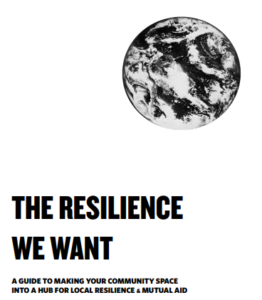
This guide introduces the vision and model of a “resilience hub” – a space where people can take more pride in their neighborhood, learn new skills together, provide for basic needs, prepare for disruptions, and build a more inclusive and joyful community. -
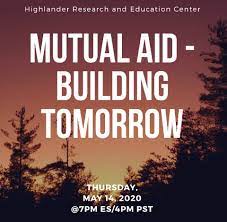
Further exploration in mutual aid and how to build our mutual aid infrastructure and movements. -

Join us in conversation with grassroots organizers who are imagining and building a world where our needs are met, we can live with dignity, and we care for each other -
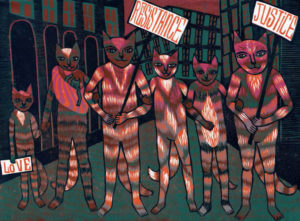
In recent years, I have been spending more of my time helping organizations doing work I care about (mostly work to end borders, police and prisons) to build their organizational infrastructure to make it work and prevent conflicts that can tear us apart. -
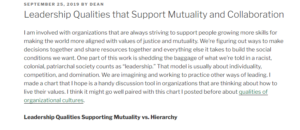
I am involved with organizations that are always striving to support people growing more skills for making the world more aligned with values of justice and mutuality. We’re figuring out ways to make decisions together and share resources together and everything else it takes to build the social conditions we want. -
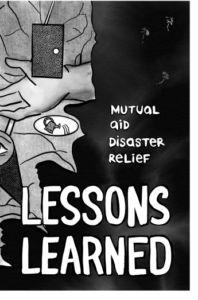
Mutual Aid Disaster Relief
This zine is a compilation of some of the major lessons Mutual Aid Disaster Relief has learned through the network of organizers and activists engaging in disaster response work. -

For anyone interested in following along with the class I am teaching this quarter, Queer and Trans Mutual Aid for Survival and Mobilization, or using all or part of the syllabus in a community reading group, I thought I’d share some of the discussion questions I am using in class. -
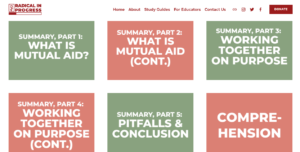
A study guide of Dean Spade’s 2020 book ‘Mutual Aid: Building Solidarity During This Crisis (and the Next).’ -
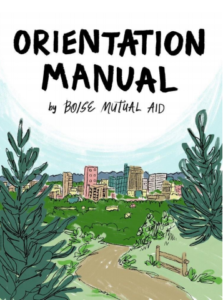
Our efforts are only possible through widespread community participation and support. Thank you for getting more involved! This manual will give you an idea of different ways to get plugged in to our weekly food and survival gear distribution. We aspire to expand and create additional ways mutual aid can be practiced in our community. If you have any ideas on how to do that, take the lead knowing that our community will support you! -
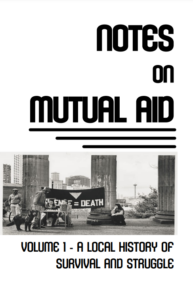
The present wave of mutual aid work is at a crossroads. A solid foundation for future work has been established, but it is vital that groups avoid stagnant patterns, non-profit and electoral co-option, or settling into a wholly reactive pattern of responding only when attacks intensify. -
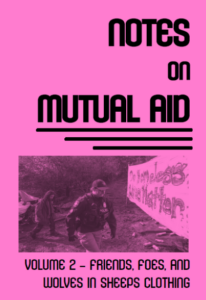
This zine is the second in a series that explores and critiques the budding movement of mutual aid groups around the Pacific Northwest. Our own experiences, observations, and
research are synthesized with accounts gained from networking with other groups near and far. The first zine explored mutual aid’s history and theory, while this zine will dive deeper into the various enemies and allies mutual aid crews may encounter.


